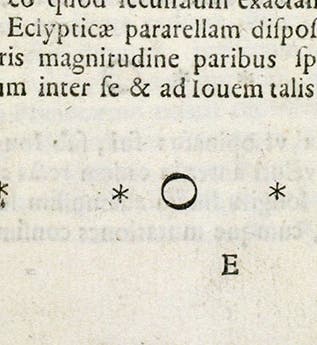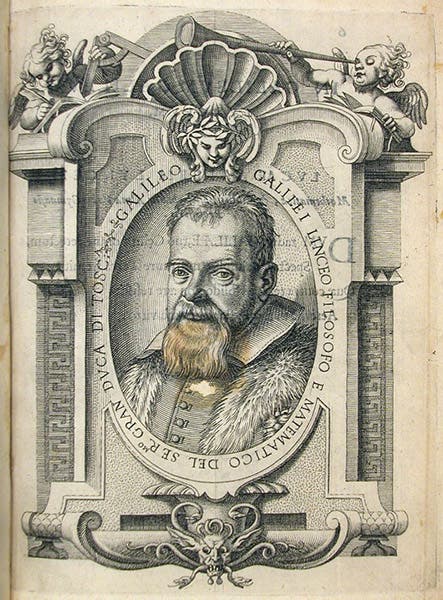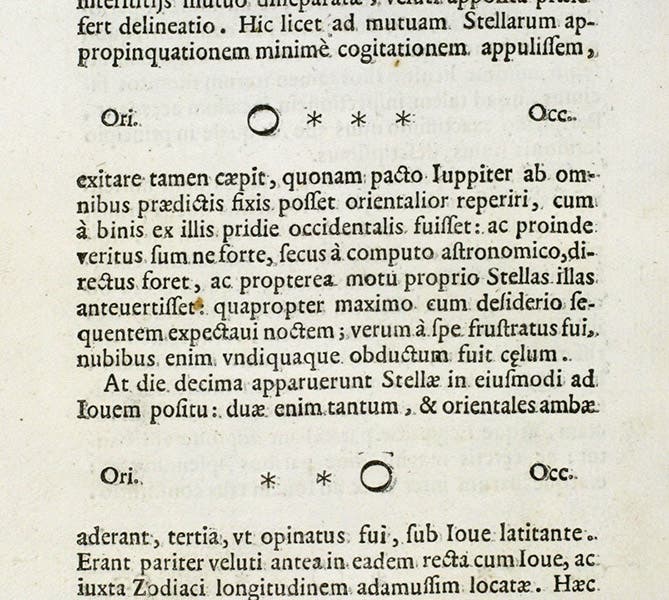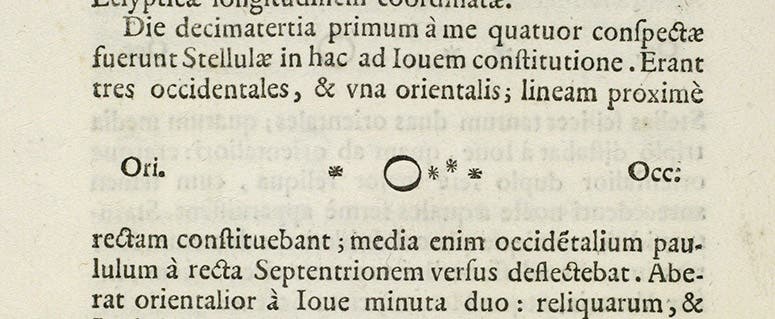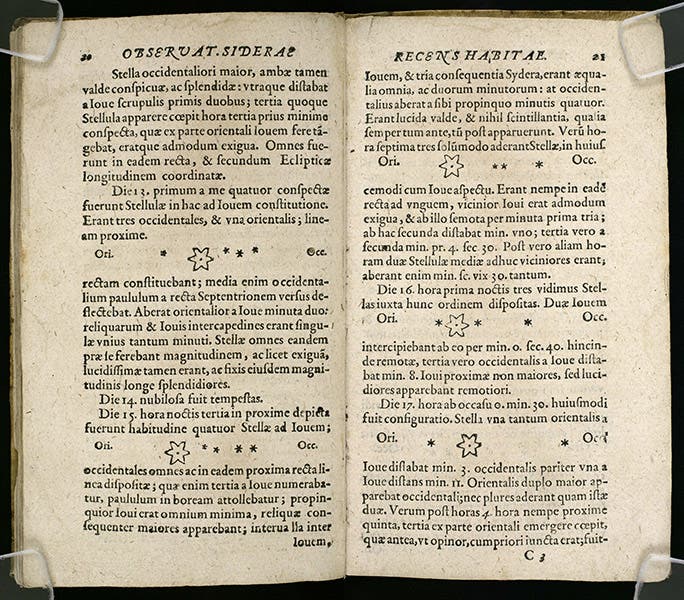Scientist of the Day - Galileo Galilei
Jan. 7, 1610 is a day well-known to planetary astronomers, as it marks the birth of their discipline. On that day, in the late evening, Galileo Galilei first trained his new 20-power telescope on Jupiter. He had previously looked primarily at the Moon, and the stars, with a smaller 8-power instrument. He was surprised to find not only Jupiter in his field of view, but three small stars, lined up with Jupiter and parallel to the ecliptic (the imaginary path taken by the Sun and the planets (more or less) as they move through the heavens). Two of the stars were to the east of Jupiter and one was to the west. Galileo made a sketch and did not think much more about it. We show you the printed version of that sketch as it appeared in his Sidereus nuncius (Sidereal Messenger) published two months later (first image). East is to the left and west is right in all the diagrams.
The next night, Jan. 8, Galileo returned to Jupiter with his telescope and was surprised to find that the stars were in different positions relative to Jupiter. All three lay to the East. Galileo observed that Jupiter was supposed to be in retrograde, but perhaps that was an error, and Jupiter was moving directly and had passed the two stars that, the night before, lay to the east (top diagram in third image, below).
Jan. 9 was cloudy and Galileo could make no observations. On Jan. 10, the skies were clear, and he found that Jupiter was now west of the stars, but one was missing. He thought perhaps it was behind Jupiter. He began to suspect strongly that it was not Jupiter moving back and forth, but the three stars (bottom diagram on third image, above).
After observing two stars near Jupiter on Jan. 11 and three stars on Jan. 12, Galileo was further surprised on Jan. 13 to see four stars strung out next to Jupiter, three on the right and one on the left (fourth image, above). He had already concluded that these were not stars but satellites circling Jupiter, and now he was sure of it. He would observe daily for almost two months, but his conclusion was only confirmed: Jupiter had four moons that circle the planet, of different sizes, and with different periods, which he was able to work out. Galileo was the first person since prehistoric times to find a new planetary object in the heavens – and he had found four of them!
Galileo published his results in his Sidereus nuncius on Mar. 13, 1610. In a bid for patronage, he named Jupiter’s four moons the “Medicean stars,” after the Medici family of Florence, and announced that name right on the title page of his book (fifth image, above). The Grand Duke Cosimo II de’ Medici was pleased and promptly invited Galileo to take up the position of “Philosopher and Mathematician” to the court in Florence. Galileo was happy to accept.
We wrote a post on Galileo and the Sidereus nuncius some years ago, but in that essay we discussed only Galileo’s drawings of the Moon and stars, so this post supplements that one. In the earlier post, we also discussed a pirated edition of the Sidereus nuncius that was published in Frankfurt shortly after the original was printed in Venice, and which we have in our collections. The woodcuts of the moon in the Frankfurt piracy are greatly inferior to the engravings in the Venice edition. We thought it would be interesting to compare the daily diagrams of Jupiter’s moons in the two editions, and so we show page openings from each that show the moons as drawn from Jan. 12 to Jan. 17, 1610 (sixth and seventh images below, with the Venice edition on top and the Frankfurt edition below). We see that the Frankfurt printer did reasonably well at getting the moons in the right position, although sometimes Galileo’s attempt to distinguish the larger moons from the smaller ones got lost. You can also see that Galileo made two drawings of Jupiter’s moons on Jan. 15 (bottom of left page and top of right in both images), because the innermost of Jupiter’s moons disappeared behind the planet during the course of the night!
The discovery of Jupiter’s moons was important for Galileo’s budding Copernican views because it removed one of the objections often made to the heliocentric system of Copernicus, namely that it required two centers of motion, the Earth, which had a moon circling about it, and the Sun, about which the planets (and the Earth) orbited. Galileo could now show, with his evidence that Jupiter had moons, that Nature was not averse to multiple centers of motion.
In our first post on Galileo, we showed a portrait that was printed in the first Latin edition of his Dialogo, one of two contemporary portraits of Galileo in our collections. We show the other here (second image), an engraving included in Galileo’s book on sunspots of 1613.
Dr. William B. Ashworth, Jr., Consultant for the History of Science, Linda Hall Library and Associate Professor emeritus, Department of History, University of Missouri-Kansas City. Comments or corrections are welcome; please direct to ashworthw@umkc.edu.

